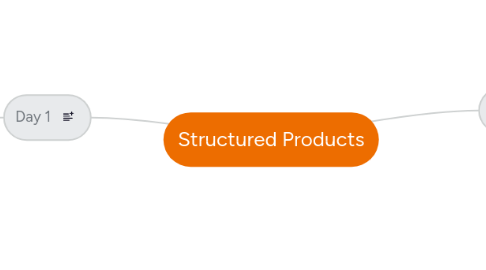
1. Day 1
1.1. 101 - An overview of the markets
1.1.1. 101.1 - Types of markets
1.1.2. 101.2 - Market participants
1.1.3. 101.3 - Instrument Classes
1.1.3.1. 101.3.1 - Assets
1.1.3.2. 101.3.2 - Spot Trades
1.1.3.3. 101.3.3 - Forwards and Futures
1.1.3.4. 101.3.4 - Options
1.1.3.4.1. 101.3.4.1 - Vanila
1.1.3.4.2. 101.3.4.2 - Component Trades
1.1.3.4.3. 101.3.4.3 - Exotic Options
1.1.3.5. 101.3.5 - Swaps
1.1.3.6. 101.3.6 - Securities
1.1.3.6.1. 101.3.6.1 - Bonds
1.1.3.6.2. 101.3.6.1 - Stocks
1.1.3.6.3. 101.3.6.2 - Hybrids
1.1.3.6.4. 101.3.6.3 - Funds ETF's REITS
1.1.3.7. 101.3.7 - Guarantees
1.1.3.7.1. 101.3.7.1 - Performance Bond
1.1.3.7.2. 101.3.7.2 - Surety bond
1.2. 102 - What is a structured product
1.2.1. 102.1 - Some of the economic benefits
1.2.1.1. 102.1.1 - Types of investment customers
1.2.1.1.1. 102.1.2.1 - Hedging
1.2.1.1.2. 102.1.2.2 - Speculating
1.2.1.1.3. 102.1.2.3 - Cross-border investments
1.2.1.2. 102.1.2 - Types of corporate customers
1.2.1.2.1. 102.1.2.1 - Hedging
1.2.1.2.2. 102.1.2.2 - Cash Management
1.3. 103 - Front Office (How are structured products sold)
1.3.1. 103.1 - The termsheet
1.4. 104 - Front to back processes
1.4.1. 104.1 - New Product Design
1.4.2. 104.2 - Middle Office
1.4.2.1. 104.2.1 - Market Risk
1.4.2.2. 104.2.2 - Counterparty Risk
1.4.2.3. 104.2.3 - Valuation
1.4.3. 104.3 - Back Office
1.4.3.1. 104.3.1 - Clearing and Settling
1.4.3.2. 104.3.2 - Custody
1.4.3.3. 104.3.3 - Collateral Management
1.4.4. 104.4 - Compliance
1.4.5. 104.5 - Regulation
1.5. 105 - Regulation
1.5.1. 105.1 - Trends in regulation 2013
1.5.1.1. 105.2 - Central Counterparty Clearing
1.5.1.2. 105.3 - Dodd frank wall street reform act
1.5.1.3. 105.4 - FACTA
1.5.1.4. 105.5 - AML
1.5.1.5. 105.6 - Basel II / III
1.5.2. 105.2 - Global regulation concerns
1.5.3. 105.3 - Trade Volumes
2. Day 2
2.1. 201 - How to audit an investment bank
2.1.1. 201.1 - Key audit areas and a framework
2.2. 202 - Risk Management
2.2.1. 202.1 - Market Risk
2.2.1.1. 202.1.1 - Using The Greeks
2.2.1.2. 202.1.2 - Volatility Smiles
2.2.1.3. 202.1.3 - The problems with VaR
2.2.1.4. 202.1.4 - Hedging Market Risk
2.2.1.5. 202.1.5 - Crowded Markets & Liquidity Funding
2.2.1.6. 202.1.7 - Basis Risk
2.2.1.7. 202.1.8 - Stress Testing and the Europe experience
2.2.2. 202.2 - Counterparty Risk
2.2.2.1. 202.2.1 - PFE / CLU working examples
2.2.2.2. 202.2.2 - CVA / DVA Calculations
2.2.2.3. 202.2.3 - Hedging Counterparty risk
2.2.2.4. 202.2.4 - Effects of leverage
2.2.2.5. 202.2.5 - Understanding Wrong Way Risk
2.2.3. 202.3 - Basel II / III Risk and Capital
2.2.4. 202.4 - Regulatory Reporting
2.3. 203 - Ethical Banking
2.3.1. 203.1 - Wash Trading
2.3.2. 203.2 - Painting the tape
2.3.3. 203.3 - Abusive Squeezes
2.3.4. 203.4 - Pump and Dump
2.3.5. 203.5 - Trash and Cash
2.3.6. 203.6 - Dealing ahead
2.3.7. 203.7 - Advisory vs Dealing
2.4. 204 - Valuation Techniques
2.4.1. 204.1 - What is needed to value structured products
2.4.2. 204.2 - What are the common problems with valuation
2.4.2.1. 204.2.1 - Typical model errors
2.4.2.2. 204.2.2 - Portfolio and Netting Effects

